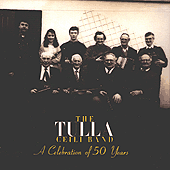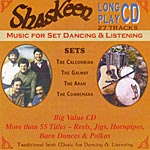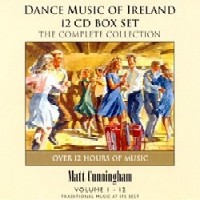![]() The modern revival
The modern revival
In spite of the demise of the large country house dances, after the passing of the Public Dance Halls Act of 1935, set dancing survived in the parts of the country that most consciously valued traditions. While the local halls catered mostly for céilí dancing, sets indigenous to the area sometimes survived. In this way, the Caledonian Set in Clare, the Castle or Cashel Set in Tipperary and many sets in Kerry and Cork continued to be danced, even as part of the evenings entertainment in the halls. It has been said that, even though the céilí dances were held to be more Irish, the only dances that could be seen in the Kerry Gaeltacht were sets. However, other sets which had flourished in the 1930s, such as the Labasheeda Reel Set, the Lancers, the Orange and Green and the Paris Set in Clare, went into decline and were it not for the dedication and interest of many old time music - and dancing masters, they might never have been revived. The work done by these instructors and by other, later, enthusiasts ensured that we now have possibly the richest store of old traditional sets ever. Undoubtedly, much has been lost with the passing years and the sets of today may in part be different, but if we accept that dancing is an evolving art, it should be possible for even purists to accept change. The founding of Comhaltas Ceoltòirí Éireann in 1951 lead to a strong renewal of interest in traditional Irish music. In its wake, the dancing also revived. People danced céilí and sets, at fleadhanna and at céilí dances.  The era of the great céilí bands, such as the Kilfenora, the Tulla, the Aughrim Slopes and the Castle must have been exciting, as they stirred the hearts and feet of dancers wherever they played. The next development to affect the revival of set dancing was the series of competitions organised by the Gaelic Athletic Association and by Comhaltas in the 1970s. Teams of set dancers from various part of the country took part in the competitions, thus showing their own set and style of dancing to all. This inspired others to look for and revive their own local sets, leading in a variety never seen so universally before. A less pleasing aspect of competition dancing was the introduction by the dancers of variations in order to make the figure movements more intricate and pleasing to the adjudicators. The figures may have improved and become more coordinated but in some cases the sets lost much of their traditional character and style in the process. One can argue that the innovators were only continuing what had always been part of the evolutionary process but many of the old sets were changed drastically, in style and even in steps. In some of the commercially run set competitions today, it is easy to see that while the patterns, teamwork, costumes and footwork are of the highest standard, the choreography and battering steps danced are alien to what would have been danced at crossroads and in house dances in the past. Another danger is the tendency of people to abandon their own set in preference to a more complicated and successful one, in order to achieve competition success. On the other hand, it is good to see in more recent times the greater variety of sets danced in competitions. In the wake of the present set dancing revival there are new bands being formed all the time, in all parts of the country.
The era of the great céilí bands, such as the Kilfenora, the Tulla, the Aughrim Slopes and the Castle must have been exciting, as they stirred the hearts and feet of dancers wherever they played. The next development to affect the revival of set dancing was the series of competitions organised by the Gaelic Athletic Association and by Comhaltas in the 1970s. Teams of set dancers from various part of the country took part in the competitions, thus showing their own set and style of dancing to all. This inspired others to look for and revive their own local sets, leading in a variety never seen so universally before. A less pleasing aspect of competition dancing was the introduction by the dancers of variations in order to make the figure movements more intricate and pleasing to the adjudicators. The figures may have improved and become more coordinated but in some cases the sets lost much of their traditional character and style in the process. One can argue that the innovators were only continuing what had always been part of the evolutionary process but many of the old sets were changed drastically, in style and even in steps. In some of the commercially run set competitions today, it is easy to see that while the patterns, teamwork, costumes and footwork are of the highest standard, the choreography and battering steps danced are alien to what would have been danced at crossroads and in house dances in the past. Another danger is the tendency of people to abandon their own set in preference to a more complicated and successful one, in order to achieve competition success. On the other hand, it is good to see in more recent times the greater variety of sets danced in competitions. In the wake of the present set dancing revival there are new bands being formed all the time, in all parts of the country.  In recent years we have seen the arrival of Templehouse, Gold Ring, Moving Cloud, Esker Riada, Michael Sexton Céilí Band and New Kilfenora among others. These, along with Fòdhla, Siamsa, Shaskeen, Sheelin, Seán Norman's Band and Matt Cunningham ensure that the movement continues to grow. The striking phenomenon of the 1980s and 1990s was the spread of set dancing workshops and set dancing céilís around the country. This is due to the modem set dancing-masters, many of whom teach a wide repertoire of sets from all parts of Ireland. Perhaps the man who has done more than anyone else to inspire this revival is Connie Ryan, a Tipperary man, who has brought set dancing to every corner of Ireland and indeed far beyond. Connie has been involved in dancing for most of his life and his drive, enthusiasm and obvious love of dancing has inspired set dancing people everywhere. The organisers of the Willie Clancy Summer School in Milltown Malbay, County Clare also played a big part in the revival.
In recent years we have seen the arrival of Templehouse, Gold Ring, Moving Cloud, Esker Riada, Michael Sexton Céilí Band and New Kilfenora among others. These, along with Fòdhla, Siamsa, Shaskeen, Sheelin, Seán Norman's Band and Matt Cunningham ensure that the movement continues to grow. The striking phenomenon of the 1980s and 1990s was the spread of set dancing workshops and set dancing céilís around the country. This is due to the modem set dancing-masters, many of whom teach a wide repertoire of sets from all parts of Ireland. Perhaps the man who has done more than anyone else to inspire this revival is Connie Ryan, a Tipperary man, who has brought set dancing to every corner of Ireland and indeed far beyond. Connie has been involved in dancing for most of his life and his drive, enthusiasm and obvious love of dancing has inspired set dancing people everywhere. The organisers of the Willie Clancy Summer School in Milltown Malbay, County Clare also played a big part in the revival.  Joe O'Donovan began set classes there and they were so successful that there is now a plenitude of teachers available for the week. Other summer festivals continue the trend, so that now it is possible to dance the summer through. Perhaps the greatest development evident now, is the interest in set dancing in all the major towns and cities. Sets were always danced in the rural areas but it is only since the revival in the 1970s that the urban population have been involved to such an extent. Another interesting side is that this interest is not confined to any one social group or area. Classes are held and céilís run in all kinds of places, from GAA to Rugby clubs and in practically all kinds of social clubs and public premises. Dancing's move into big halls and clubs was necessary in light of the number of dancers participating. Another development is the presence of set dance callers at the dancing nights. Their presence enables anybody with a reasonable knowledge of the sets to take part in the evening's activities. Many people disapprove of this aspect of the dances but if it means that more people can participate and enjoy the sets it is certainly worthwhile. What makes the Country sets of today unique is the variety of steps and dancing styles that have evolved with the passing years. This is what gives them their enduring popularity with so many people. It is vitally important that we make every effort to preserve the various styles as accurately as possible; otherwise the sets will gradually lose their colour and individuality and eventually disappear, with only the best-known surviving. It is ironic that popularity is now one of the greatest dangers to their survival. As people travel more and bring their own styles of dancing witm them, there is a danger of too much uniformity. While it is great to see and appreciate the better dancers, we should remember that if all danced the one style, no matter how attractive, then the less popular sets would not long survive. One of the recurring comments in dance histories since the sixteenth century is the complaint that dancing has become too wild and fast, losing its quality in the process. It would appear that all ages of dancing had the same problem and it is one of the greatest dangers to traditional set dancing today. Style and steps are being sacrificed to speed and the result is that steps are becoming almost uniform; it is impossible to dance steps properly at speeds that are too fast for them. The result is that the steps are sometimes changed and simplified to suit the rapid music. Significantly, in the more traditional dancing areas, such as Clare, the music is usually played at a slower, more suitable pace and the intricate steps so admired by all dancers continue to be danced there. We can only hope, that more people will come to understand and appreciate the music and realise that speed is a hindrance rather than an asset to enjoyment. Without the guidance of a central authority, it is the responsibility of the modern dance instructors to learn the country set dances in their traditional form, teach them properly and thus ensure that they are preserved for future generations.
Joe O'Donovan began set classes there and they were so successful that there is now a plenitude of teachers available for the week. Other summer festivals continue the trend, so that now it is possible to dance the summer through. Perhaps the greatest development evident now, is the interest in set dancing in all the major towns and cities. Sets were always danced in the rural areas but it is only since the revival in the 1970s that the urban population have been involved to such an extent. Another interesting side is that this interest is not confined to any one social group or area. Classes are held and céilís run in all kinds of places, from GAA to Rugby clubs and in practically all kinds of social clubs and public premises. Dancing's move into big halls and clubs was necessary in light of the number of dancers participating. Another development is the presence of set dance callers at the dancing nights. Their presence enables anybody with a reasonable knowledge of the sets to take part in the evening's activities. Many people disapprove of this aspect of the dances but if it means that more people can participate and enjoy the sets it is certainly worthwhile. What makes the Country sets of today unique is the variety of steps and dancing styles that have evolved with the passing years. This is what gives them their enduring popularity with so many people. It is vitally important that we make every effort to preserve the various styles as accurately as possible; otherwise the sets will gradually lose their colour and individuality and eventually disappear, with only the best-known surviving. It is ironic that popularity is now one of the greatest dangers to their survival. As people travel more and bring their own styles of dancing witm them, there is a danger of too much uniformity. While it is great to see and appreciate the better dancers, we should remember that if all danced the one style, no matter how attractive, then the less popular sets would not long survive. One of the recurring comments in dance histories since the sixteenth century is the complaint that dancing has become too wild and fast, losing its quality in the process. It would appear that all ages of dancing had the same problem and it is one of the greatest dangers to traditional set dancing today. Style and steps are being sacrificed to speed and the result is that steps are becoming almost uniform; it is impossible to dance steps properly at speeds that are too fast for them. The result is that the steps are sometimes changed and simplified to suit the rapid music. Significantly, in the more traditional dancing areas, such as Clare, the music is usually played at a slower, more suitable pace and the intricate steps so admired by all dancers continue to be danced there. We can only hope, that more people will come to understand and appreciate the music and realise that speed is a hindrance rather than an asset to enjoyment. Without the guidance of a central authority, it is the responsibility of the modern dance instructors to learn the country set dances in their traditional form, teach them properly and thus ensure that they are preserved for future generations.
![]()